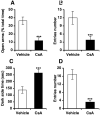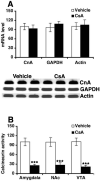Blockade of protein phosphatase 2B activity in the amygdala increases anxiety- and depression-like behaviors in mice
- PMID: 19716552
- PMCID: PMC2787791
- DOI: 10.1016/j.biopsych.2009.07.004
Blockade of protein phosphatase 2B activity in the amygdala increases anxiety- and depression-like behaviors in mice
Retraction in
-
Blockade of protein phosphatase 2B activity in the amygdala increases anxiety- and depression-like behaviors in mice.Biol Psychiatry. 2014 Jun 15;75(12):999. doi: 10.1016/j.biopsych.2014.05.004. Biol Psychiatry. 2014. PMID: 24987761 Free PMC article. No abstract available.
Abstract
Background: Organ transplant patients receive chronic administration of the calcineurin inhibitor cyclosporin-A (CsA) and demonstrate increased incidence of mood disorders. Significant calcineurin expression can be observed with immunohistochemistry in the amygdala, a brain area important for behaviors related to mood disorders and anxiety. It is therefore important to determine whether chronic blockade of calcineurin might contribute to symptoms of anxiety and depression in these patients.
Methods: Pharmacological CsA and viral-mediated gene transfer (adeno-associated viral expression of short hairpin RNA [AAV-shRNA]) approaches were used to inhibit calcineurin activity globally and selectively in the amygdala of the mouse brain to determine the role of calcineurin in behaviors related to depression and anxiety.
Results: Systemic inhibition of calcineurin activity with CsA or local downregulation of calcineurin levels in the amygdala with AAV-delivered shRNAs targeting calcineurin A increased behavioral measures of anxiety in both the elevated plus maze and light/dark tests with no changes in locomotor activity. In the forced swim and tail suspension models of depression-like behavior, calcineurin blockade in the amygdala increased immobility similarly to manipulations that lead to a depression-like phenotype.
Conclusions: Taken together, these data demonstrate that decreasing calcineurin activity in the amygdala increases anxiety- and depression-like behaviors. These studies suggest that chronic administration of CsA to organ transplant patients could have significant effects on anxiety and mood and that this should be recognized as a clinical consequence of treatment to prevent transplant rejection.
Figures







References
-
- Calne RY, Rolles K, White DJ, Thiru S, Evans DB, McMaster P, et al. Cyclosporin A initially as the only immunosuppressant in 34 recipients of cadaveric organs: 32 kidneys, 2 pancreases, and 2 livers. Lancet. 1979;2:1033–1036. - PubMed
-
- Calne RY, White DJ, Thiru S, Evans DB, McMaster P, Dunn DC, et al. Cyclosporin A in patients receiving renal allografts from cadaver donors. Lancet. 1978;2:1323–1327. - PubMed
-
- Kahan BD, Flechner SM, Lorber MI, Golden D, Conley S, Van Buren CT. Complications of cyclosporine-prednisone immunosuppression in 402 renal allograft recipients exclusively followed at a single center for from one to five years. Transplantation. 1987;43:197–204. - PubMed
-
- de Groen PC, Aksamit AJ, Rakela J, Forbes GS, Krom RA. Central nervous system toxicity after liver transplantation. The role of cyclosporine and cholesterol. N Engl J Med. 1987;317:861–866. - PubMed
-
- Katon WJ. Clinical and health services relationships between major depression, depressive symptoms, and general medical illness. Biol Psychiatry. 2003;54:216–226. - PubMed

